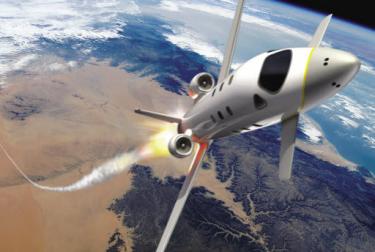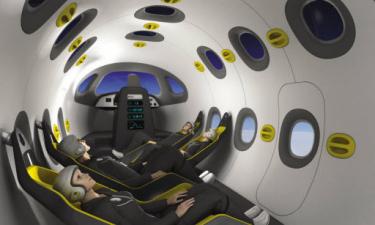
Yesterday the European aerospace company EADS Astrium announced its proposal to develop a suborbital vehicle to serve the space tourism market. While this is a new design, the concept of operations is almost identical to what Rocketplane Global has been developing for several years: a vehicle the size of a business jet that takes off under jet power, ignites a rocket engine at altitude to fly a suborbital trajectory, then land again under jet power. If nothing else, the Rocketplane people should feel pleased that concept has been “borrowed” by a big aerospace company (even though Astrium’s actual vehicle design is somewhat different from the Rocketplane XP.) It also appears that those earlier reports about the use of an A380F as a carrier aircraft turned out to be unfounded.
EADS didn’t release a lot of technical details about the vehicle design, but one thing about it struck me as odd. Look at the seating design of the cabin:

I can understand why the designed put the seats sideways: it makes it easy for passengers to look out windows, and may allow for a shorter passenger cabin. However, during ascent, this design means that the g-forces experienced by passengers will be on the Gy vector: across the body from left to right (or right to left, depending on how you’re oriented), which doesn’t seem as preferable as taking the g-forced through the body on the Gx vector. One of the features of the SpaceShipTwo cabin, for example, is the movable seat, so that the g-forces go through the Gx vector on both launch and reentry.
So what does Astrium’s entry into the market mean for space tourism in general, and other companies in the market? The endorsement of the suborbital space tourism concept by one of the world’s largest aerospace companies does certainly give industry an additional air of legitimacy, although it’s not clear just how important or necessary that endorsement is (except, perhaps, in the eyes of some contrarians.) And the addition of new ventures may increase the likelihood that one or more of them are eventually successful.
However, how seriously should this proposal be taken? According to the BBC Astrium estimates that it will cost €1 billion (US$1.3 billion) to develop the vehicle, and that the company will seek additional investment. They plan to charge €150,000-200,000 (US$195,000-265,000) per ticket, which puts them on the high end of known prices, particularly compared to Virgin’s $200,000 list price. It’s tough to see how the business plan for this would close, given the huge investment required: at the €200K ticket price, that means a revenue per flight of €800K. That would mean Astrium would have to fly the vehicle 1,250 times to recoup their investment—and that assumes a marginal cost per flight of zero! That’s sharply different from other companies, which require anywhere from five to 20 times less money to develop their vehicles, making it much more likely they can fly enough to pay off the investment.
A conspiratorially-minded person might wonder if this is an example of what’s known in the computer industry as FUD (fear, uncertainty, and doubt): by playing up their experience and putting such a high price tag on the venture, it could create uncertainty in the market that smaller, less experienced companies can pull off their plans. That may not be an intentional effect, but it is something to look out for in the months to come.

Hello Jeff, You missed a key point on the seats. They pivot around the attachment points so that the passengers are aligned rearside to the spacecraft x-axis (body aligned on Gx-axis) during launch acceleration and they are rearside on the negative z-axis during weightlessness and reentry. I find this actually to be a novel way to provide good seating while freeing up space in the cabin for floating around. It is like a space hammock that swings to the best position depending upon acceleration forces.
[…] reaction (and clarification) on the EADS Astrium announcement this week about its plans to develop a suborbital vehicle for space tourism […]
Hi,
I think you missed another point in your article. Your talk about the wierd business plan which needs 1000+ flight to pay for the 1b€ investment doesn’t really make sense to me… EADS doesn’t plan to operate those rocketplanes, just to build them and then sell them to some tourism/spaceliner companies. Let’s say the price is 40 million for each plane, they need to sell 20 of them and that’s it (for paying the initial development/testing/prototypes costs).They don’t really care about what happen next.
Let’s say one company buy one, they will need to fly it 50 times to pay for its price (not including operational costs).
The risk in terms of number of flights recquired is divided and taken by other companies operating it, they just need to sell the planes.
(obviously the numbers I have used here are examples)
For those interested, the coverage has been quite good in France with all major TV news programs and main newspapers mentioning it. Also, lots of comments from readers have been posted on newspaper websites regarding that news and a fair share of them is quite negative, especially concerning the environment facet of the plane: “We let rich people kill the planet” and the like which is going to make Astrium’s search of investment quite tricky (EADS spokesmen said they wanted some regional/EU public investment too)
Anyway, good luck to them!
What’s interesting to me is the Development Budget.
Astrium Says It’s a Billion dollars to build a tourist spaceship.
Virgin Galactic says it’s $250 Million Dollars to do this.
Rocketplane says it’s $13 Million.
One suspects the Rocketplane staff of having slipped a decimal
somewhere important.
Based on my experience of diving to the Titanic in a submersible, the windows in this schematic are way too far from the passenger’s eyes. In the submersible my nose was practically on the porthole almost 100% of the time. This position gave me, due to the thickness of the glass about a 160 degree angle of vision outside the sub. Had I sat as far back in the sub as this schematic shows, you engineers figure this out, I would have had about a 10 degree field of vision. As Rocketplane XP’s first passenger, the schematic for this spaceship is unacceptable for the simply because the #1 reason for both diving to the Titanic and taking the space ride is to look out the window to see the view.
Another reason the seat design doesn’t make sense is that we humans are of various heights. I’m 5′ 6″. With stretch room, the vehicle would have to be say 6′ 6″ wide on the inside (thus, my eyes would be 6′ from the far window!). But a man might be 6′ 6″ which would mean the vehicle would need to be 7′ 6″ on the inside. Rich basketball players might have to be eliminated because they are too tall for the width of the space plane.
Hello Jeff, you actually miss another key point about the seats : they slide (along a sort of rail) to minimize the G-force ! Good idea isn’t it ?!!
Congratulations for your website !
… and sorry if they are any english mistake, I’m a french galactic websurfer !